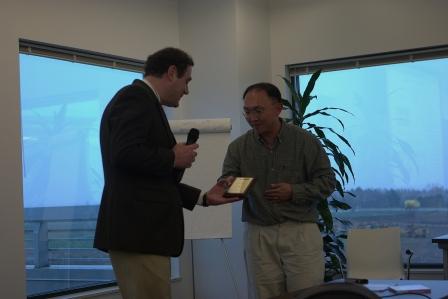|
 |
 |
|

Technical
Seminar |
 |
 |
|
|
|
Challenges in Serial Electrical Interconnects at 5
to 10 Gb/s and Beyond |
|
|
DATE/TIME
Thursday, March 29, 2007 (4:30pm to 6:00pm) |
|
PLACE
AMD Fort Collins Campus (Fort
Collins, CO) |
|
DIRECTIONS
|
|
From I-25, take Harmony Road Exit (Exit 265) westbound, and enter
AMD campus on right immediately following Harmony/Ziegler intersection.
AMD is located on the NW
corner of Harmony Road and Ziegler Road. Proceed to 3rd floor for
escort to seminar auditorium. Non-AMD
employees: please arrive at 4:15pm for security sign-in and escort. |
|
COST
Free. As always, food &
drinks will be provided. |
|
RSVP
Send e-mail to Tin Tin Wee at
tintin.wee@amd.com. |
|
|
ABSTRACT
|
|
Modern high-performance computing and
networking system designs are pushing data
rates for inter-chip communications to unprecedented speeds. Both
on-board buses such
as CPU-Memory and CPU-Coprocessor and backplane buses in blade systems,
storage,
and networking gear are being increased in data rate to a range of 5 to
10Gb/s in modern system designs. These high data rates require the
design of advanced equalization I/O cores which are capable of operating
in the challenging high frequency channel with higher loss, higher
crosstalk, and more reflection distortion compared to lower data rate
systems. This talk will cover highlights from a study of equalization
performance on 10Gb/s IEEE 802.3ap backplanes presented by the author at
the 2006 ISSCC ATAC. Topics covered include an overview of the
challenges presented by the electrical interconnect channel at high
data rates, including channel characteristics of a range of informative
backplanes presented to the IEEE 802.3ap "Ethernet over Backplane"
standard. Both transmitter and receiver (typically FFE and DFE)
equalization will be compared and contrasted. The system level
architecture and performance of a modern 10Gb/s I/O core which realizes
FFE and DFE equalization will be discussed. An overview of behavioral
link simulation will be presented, illustrating components of a typical
link simulation tool along with important I/O core parameters which need
to be modeled to accurately predict system performance. Example
simulation results which summarize expected performance as a function of
various system design parameters such as FFE and DFE length and I/O core
degradations are given with a focus on the IEEE 802.3ap application
channels. Conclusions are drawn summarizing major challenges
facing modern high data rate I/O system designs. |
|
PRESENTATION SLIDES
pdf |
|
REFERENCES |
-
IEEE 802.3ap Backplane Ethernet Task Force
- J. Bulzacchelli et al., "A
10-Gb/s 5_Tap DFE/4-Tap FFE Transceiver in 90-nm CMOS Technology,"
IEEE J. Solid-State Circuits, vol. 41, no. 12, Dec. 2006
(copyright by IEEE)
- M. Meghelli et al., "A
10Gb/s 5-Tap-DFE/4-Tap-FFE Transceiver in 90nm CMOS," ISSCC 2006
(copyright by IEEE)
- T. Beukema et al., "A
6.4Gb/s CMOS SerDes Core with Feed-forward and Decision-Feedback
Equalization," IEEE J. Solid-State Circuits, vol. 40, no. 12,
Dec. 2005 (copyright by IEEE)
- M. Sorna et al., "A
6.4Gb/s CMOS SerDes Core with Feedforward and Decision-Feedback
Equalization," ISSCC 2005 (copyright by IEEE)
|
|
|
TROY BEUKEMA (IBM
Research, Yorktown Heights, NY)
|
 |
Troy Beukema received the BSEE and
MSEE degrees from Michigan Technological University, Houghton, in
1984 and 1988, respectively. His industry experience includes digital
and analog circuit design and firmware development at Hewlett-Packard
in the area of communications test equipment from 1984 to 1988, and
digital signal processing algorithm design and firmware development at
Motorola applied to digital wireless communications systems from 1989 to
1995. In 1996, he joined IBM Research in Yorktown Heights, NY, where he
is involved in both wireless and wireline communication systems
research. His most recent activity at IBM focuses on
decision-feedback-equalization based transceiver designs for IBM high
speed serial I/O ASIC cores which operate in the 5Gb/s to 10Gb/s+ range. |
|
As part of this effort, he works closely
with both IBM ASIC development
groups and colleagues in research at Yorktown in the design of receiver
analog front end architecture, clock-and-data recovery algorithms, and
equalization adaptation algorithms. He has written a fast behavioral
serial link simulator which is in use at IBM research and product
development groups to both assist in the development of advanced I/O
core architectures and provide a tool to system level designers for
analysis of end-to-end serial link performance for a wide range of high
speed I/O applications.
|
|
|
PHOTOS Courtesy of Tin Tin Wee |
|
 |
|
 |
|
 |
|
 |
|
|
|